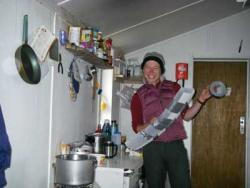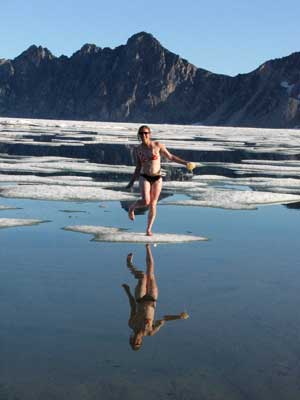After receiving a bachelor’s degree in biology from Cornell University, Rachael knew she wasn’t ready to continue on to an advanced degree. With lots of questions left surrounding ecological systems she methodically applied for numerous field positions. The first opportunity, offered for that summer, was to spend two months on the Barren Islands offshore of Homer, Alaska. After that two months working with the U.S. Fish and Wildlife Service, Rachael spent from January to May, chasing and monitoring wild turkeys in the Carmel Valley outside of Monterey, California. Since then, the sequence of her varied field work has been; four months in Kodiak, Alaska, three months at Cape Cozier on Ross Island, Antarctica, then back to Kodiak. She then switched to field opportunities in more tropical areas, initially based on Kauai, Hawaii for two months, followed by seven months on Maui, Hawaii. A final warm climate position was found in Palau for two months. Polar region work returned with four months of work at Cape Shirreff on Livingston Island, Antarctica for NOAA; three months on Buldir Island in the Aleutian chain for the U.S. Fish and Wildlife Service; and back to Cape Shirreff for another quarter year. Bringing us up to present, Rachael finds herself in Greenland, as a field assistant on the Little AukThe Little Auk is the most abundant seabird species in the Atlantic with the largest colonies located between 70-80° N on the Arctic islands of Greenland and SpitsbergenSpitsbergen is the largest island in the Norwegian High Arctic archipelago of Svalbard. To see a map of Spitsbergen and Svalbard click here.. The Little Auk belongs to the Auk family, a diverse group of seabirds in the Northern hemisphere that include the puffins, auklets and guillemots. To read more about the little auk, see pictures and and listen to the bird’s call click here. project. Prior to examining Little Auks; wild turkeys, black-legged kittiwakes, tufted puffins, chinstrap penguins, Adelie penguins, gentoo penguins, land snails of Palau, endemic forest birds of Hawaii, and auklets have all been on the viewing side of Rachael’s binoculars and field notebook.
Try mapping that sequence of employment positions.

A bit of duct tape, plastic jugs, Rachael can make anything- this is obviously a rain gutter!
With this progression, Rachael has found a developing passion for seabirds and the consequences climate change may have on their populations. With her analytical mind, constant questioning of data and research protocols and astute reasoning skills, Rachael is now investigating doctoral programs that will allow her to specialize in understanding seabirds. Everyone is glad to have her knowledge of field work, her ability to creatively solve camp problems and the laughter that resonates from her with regularity.

"I better tan quickly!" Rachael finds herself on an iceberg outside Kap Hoegh!


Comments